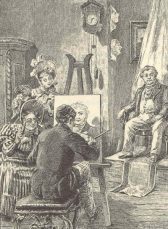
Pierre Grassou
THE HUMAN COMEDY – Honoré de Balzac Eleventh volume of works of Honoré de Balzac edited by widow André Houssiaux, publisher, Hebert and Co, successors, 7 rue Perronet – Paris (1877) Scenes from Parisian life

Pierre Grassou
PIERRE GRASSOU Short story written by Honoré de Balzac in December 1839 Signed TO ARTILLERY LIEUTENANT-COLONEL PERIOLLAS, As a token of the author’s affectionate esteem, De Balzac.
Analysis of the work What has just been said about Sarrasine and Facino Cane also applies to Pierre Grassou, written in 1839, and despite this date, just as foreign to Balzac’s work as the two preceding tales. Pierre Grassou is, organically if you like, even stranger than his predecessors, since he was quite simply Balzac’s contribution to a collective collection, Babel, intended to provide initial capital for the Société des Gens de Lettres that Balzac had just founded. So it’s a charity that Balzac could have maintained, without any inconvenience, in this modest place. It was all the more deserving in that, by agreement, Babel ‘s contributors had undertaken not to make those essential alterations to their text that are known as “author’s corrections”, in order to avoid costs. It’s easy to imagine the consequences of this commitment for Balzac, who often doubled the scope of his short stories by adding corrections.
The story Pierre Grassou de Fougères is a small, unoriginal painter of mediocre talent. To help their old friend, Léon de Lora, Schinner and Joseph Bridau, famous leaders of the Arts movement, had one of his paintings accepted at the 1829 exhibition. Although mediocre, this painting was a great success, bringing Pierre Grassou fame and fortune. At the request of Elias Magus, a dealer in curiosities, paintings and masterpieces of all kinds, Grassou agrees to paint the portraits of a bourgeois family whose daughter has a dowry of one hundred thousand francs. The Vervelle family, who had never heard of art, rallied around the artist’s name as a result of the public and press infatuation with this new artist. The Vervelle parents saw in him an excellent match for their only daughter, while Pierre Grassou, by marrying into the bourgeoisie, ensured himself a secure future. Recommended to the Vervelle family by their mutual notary, Pierre married Virginie. Today, Pierre Grassou is known in the bourgeois world as a fine portrait painter, and is considered one of the greatest artists of his time. This honest man, good husband and good father knows, however, that the artists laugh at him in the studios and that the columns don’t mention his works. Nevertheless, he continued to work and bought paintings from his famous colleagues when they were embarrassed. He is, moreover, of anonymous benevolence and perfect helpfulness. 
The characters Pierre Grassou: A mediocre painter who enjoyed great success with the petit bourgeois in the 1830s. He married Virginie Vervelle, the daughter of the wealthy bourgeois for whom he painted the picture. They will have two children. Elias Magus: Picture dealer, born 1770 – Has a daughter Noémi. Léon de Lora: Painter, born 1806. He has a brother Juan. His family, of Spanish origin, settled in Roussillon. Hippolyte Schinner: Painter, born in 1790, assumed the title of Baron. He was married to Adélaïde Leseigneur de Rouville. Joseph Bridau: Painter, born 1799. Marries a Léger. Joseph had a brother, Philippe, a soldier and Count of Brambourg (1796-1839). Philippe married Flore Brazier (1787-1828), widow of his uncle Rouget. Anténor Vervelle: Retired merchant. Married with a daughter Virginie who married Pierre Grassou. Anténor also has a sister.
1) Source analysis: Preface compiled from the complete works of the Comédie Humaine (tome XVI) published by France Loisirs 1986 under the auspices of the Société des Amis d’Honoré de Balzac.
2) Source story: Wikipedia, the universal encyclopedia.
3) Character genealogy source: “Balzac et son monde, Félicien Marceau – Gallimard”.
No Comments